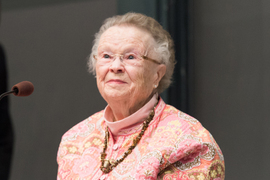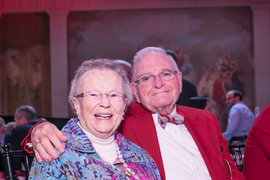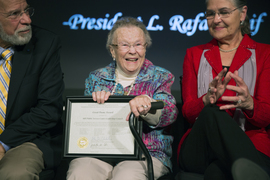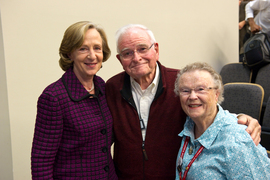Priscilla King Gray, an integral part of the fabric at MIT for more than 50 years, died on Feb. 8. She was 89.
Gray, who had been the wife of former MIT president Paul Gray ’54, SM ’55, ScD ’60 until his death in 2017, co-founded the MIT Public Service Center — since renamed in her honor as the Priscilla King Gray Public Service Center — and was a champion of public service and a leader in efforts to build community at the Institute.
She arrived at MIT when her husband joined the faculty of the Department of Electrical Engineering in 1960, and experienced Institute life with him over the next five decades as he ascended the ranks of the administration. Paul Gray served as the dean of engineering, associate provost, and chancellor, and then as MIT’s 14th president from 1980 to 1990, followed by seven years as chair of the MIT Corporation.
Throughout this time, Priscilla Gray made her own indelible mark at the Institute through her contributions to public service, while also being Paul’s confidante, sounding board, and occasional advisor.
“I didn’t have the chance to meet Priscilla Gray,” says MIT President Sally Kornbluth, who assumed the role on Jan. 1. “But her spirit feels wonderfully familiar, because, from her portrait in the front hall at Gray House, where she and Paul are painted side by side, her quiet smile warms the room. As I'm learning, Priscilla's name is synonymous with public service at MIT — a fitting legacy for someone who believed deeply in our students and their capacity to do good in the world.”
A legacy of service
Priscilla King Gray and Paul Gray met as college students in 1951, when Priscilla was at Wheaton College and Paul at MIT. They married in 1955 and spent two years at the nearby Fort Devens Army Base, where Priscilla taught second grade and gave birth to the first of their four children while Paul completed his military service. The family then moved to the Cambridge area, so that Paul could begin his PhD at MIT.
As her family grew and Paul became an MIT faculty member and then administrator, Priscilla was an active volunteer both off and on campus. Among other activities, she joined the MIT Women’s League, later saying in an MIT Infinite History interview, “In the early years, that’s really how I got to know the Institute.”
With the league, she worked to help faculty wives host events in their homes for students, and then participated in other efforts, such as raising money for and helping to reorganize Elizabeth Killian Hall (Building 14), and supporting a local shelter for people experiencing homelessness. Gray also taught crewel embroidery at MIT from 1978 to 2007.
In 1988, while her husband was the Institute’s president, she co-founded the MIT Public Service Center with dean of student affairs Shirley McBay, and served as co-chair of its steering committee for more than 23 years. The center was renamed in her honor in 2015, and is now known as the PKG Center.
“Priscilla was the mother of all of us who were students at MIT,” says Hyun-A Park ’83, MCP ’85, a member of the MIT Corporation and former president of the MIT Alumni Association. Park worked with Gray on the MIT quasquicentennial gala centered around the opening of the Wiesner Student Art Gallery. She recalls that Gray would regularly invite her to breakfast at the president’s house: “I loved those breakfasts with Priscilla. She always could talk about anything and it would be fun and interesting.”
“She welcomed students with open arms then wrapped them around us so we felt at home. I was lucky enough continue to have her ‘mother’ me throughout my life with her generosity and love,” Park says.
Vision and strategy
Today, the PKG Center has expanded beyond a “day of service” mindset; its vision of public service is now more long-term, community-informed, and academically aligned. Gray was “a true strategic thought partner” throughout the center’s evolution, says Jill Bassett, associate dean and director of the PKG Center.
Gray was “visionary in setting the stage so we could evolve in an MIT-specific way. She lived and breathed MIT and would never have wanted us to remain stagnant and stationary. As we evolved, she was thrilled that we were manifesting the MIT ethos,” Bassett says.
In 2020, the PKG Center needed support to provide opportunities for MIT students to lend their skills to the fight against Covid-19. Gray determined that it was time for the two of them to speak with then-President L. Rafael Reif, and worked carefully with Bassett to prepare for the meeting, which went successfully.
“She brought her experience as having been a first lady and knowing what Paul was grappling with,” Bassett says. “She had an extremely astute sense of political timing and framing that she helped me with, and I’m so grateful.”
“Priscilla was a wonderful and caring friend and advisor to my wife and to me during our time in Gray House,” Reif says. “She was, with Paul, such delightful role models for what it means to be MIT president and first lady. Chris and I will deeply miss her presence, her warmth, her seemingly infinite energy and her lifelong dedication to the people of MIT.”
A partner in leadership
Priscilla was a trusted advisor to Paul as he took on more administrative responsibilities, and through her community activities she often learned a great deal about students’ opinions and needs. As she recalled in her Infinite History interview, she would often hear things from MIT community members, for example, during her crewel embroidery classes, that she felt would be helpful for Paul to know — but she also knew when people were just “stirring the pot” in her presence, and kept those matters to herself, she said.
The longer Paul worked at MIT, the more the Institute demanded of him, and, in turn, his family. The pull was perhaps most acute in the late 1960s and early 1970s, as the antiwar movement swelled. During those turbulent times, Paul “lived” at MIT, Priscilla recalled later, noting that she would bring him fresh clothes each day.
To be sure, there were merrier times as well. The Grays hosted many social events for MIT community members over the years. When Paul was chancellor during the 1970s, the family hosted huge dinners on both Friday and Saturday nights at their home in Winchester, always inviting spouses as well. “We felt they shouldn’t be left out,” Priscilla recalled.
“Priscilla was for decades the heart and soul of MIT — thoughtful, considerate, gracious, and deeply interested in the well-being of everyone in the MIT community,” says Professor Eric Grimson, who is also the chancellor for academic advancement and interim vice president of open learning.
Making a home at Gray House
When Paul became president of MIT, he and his family moved into the president’s house, now named Gray House. Although his predecessor as MIT’s president, Jerome Wiesner, had opted to remain with his family in their own home, Paul and Priscilla felt it was important to live on campus during this time.
There, in addition to hosting dignitaries, memorial gatherings, faculty gatherings, and more, Priscilla started a tradition of holding dinners for undergraduate seniors. “I wanted to somehow make sure every MIT student had been in the president’s house once,” she told Infinite History.
Bonny Kellermann, director of special constituencies, who has worked at MIT for nearly 50 years, recalls that at receptions for new students and their parents, Priscilla and Paul would personally greet everyone as they entered Gray House and came through a receiving line. “Priscilla seemed to have an amazing knack of remembering the names of all of the people she had met. I was always in awe of her ability to do that,” Kellermann says.
Gray’s duties as first lady also included serving on two committees, along with builders and architects, to plan renovations of the student center and Edgerton House. She traveled with Paul frequently, including to Egypt and to Japan, where she met the emperor and empress, and to the UK, where she met Prime Minister Margaret Thatcher.
Gray was named an honorary member of the MIT Alumni Association in 1977 and received its Harold E. Lobdell ’17 Distinguished Service Award in 1985. In 1990, she also received the Bronze Beaver Award, which is the Alumni Association’s highest honor.
“From the time I first met her in 1965, Priscilla was one of my dearest friends who was woven into the tapestry of my life. My family visited ‘Aunt Priscilla’ frequently, and we talked regularly to share the joys and frustrations of life. She personified the MIT spirit of ‘I can’ in ways that nobody else imagined,” says Jim Taylor ’65, a close friend of Priscilla and Paul for 58 years. “She was never too busy to listen, always positive, and never missed an opportunity to serve others. I think Priscilla found as much satisfaction in teaching my then-4-year old son how to tie his shoes as she did interacting with the prime minister of the U.K. She was an incredible woman who lived a full, rich life and gave back much more than she ever took. I will miss her.”
Gray is survived by four children and their spouses — Virginia and Thomas Army, Amy and David Sluyter, Andrew and Yukiko Gray, and Louise and Timothy Huyck — and by 12 grandchildren, five of their spouses, and six great-grandchildren. Several of the Grays’ grandchildren have MIT ties of their own: Priscilla Army Elliott graduated from MIT in 2010; Elizabeth Gray Army currently works for the MIT Alumni Association; and Caroline Perry works in the Office of the Vice President for Research.
Gifts to MIT in Gray’s memory may be made to the Priscilla King Gray Public Service Fund.
A memorial service will be held at 1 p.m. on June 19 at the Hancock United Church of Christ in Lexington, Massachusetts, with a reception to follow. All are welcome.
















